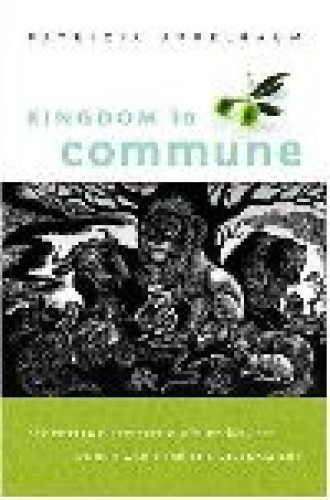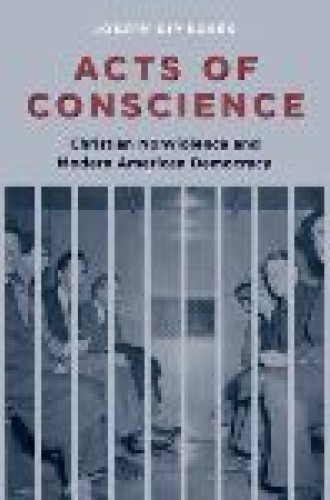Prescient pacifists
The Enlightenment has bequeathed us—Americans more than anyone else—the conviction that history is a story of progress. Such a notion seems ludicrous when one considers the violence of the contemporary world. As the British historian Eric Hobsbawm observes in his brilliant work The Age of Extremes, the 20th century “was without doubt the most murderous century of which we have record, both by the scale, frequency and length of the warfare which filled it . . . but also by the unparalleled scale of the human catastrophes it produced, from the greatest famines in history to systematic genocides.”
Given that the slaughter continues—in Afghanistan, Algeria, Iraq, Israel-Palestine, Sri Lanka, Sudan, the Democratic Republic of the Congo—it seems a propitious time for two books on 20th-century pacifism in the United States. Patricia Appelbaum’s Kingdom to Commune and Joseph Kosek’s Acts of Conscience overlap to a striking degree. They cover the same time period, roughly from 1914 to the early 1960s. Both feature Protestants in general and Quakers in particular. They focus attention on certain prominent pacifists—such as Sherwood Eddy, Harold Gray, Richard Gregg, A. J. Muste and Kirby Page—as well as on Reinhold Niebuhr, chief Protestant antagonist of the pacifists. And both authors consider how World War II affected American pacifism and the American pacifist community.
For all this, Kingdom to Commune and Acts of Conscience are quite different from each other. Appelbaum devotes much of her attention to mainline Protestantism, which “constituted the center of public religious pacifism in the 1920s and 1930s.” In those years interdenominational organizations such as the YMCA nurtured pacifism, and most mainline denominations passed resolutions opposed to war (though only a small percentage of mainline Protestant church members ever became committed pacifists). But with the approach of World War II, the mainline denominations turned away from their pacifist commitments. In the process pacifists moved toward the margins of American Protestantism and American life, becoming less distinctively or primarily Christian and adopting an antimodernism that manifested itself in commitments to cooperative economics and rural living.
At the heart of Kingdom to Com mune is a detailed discussion of pacifist culture, which, as the author asserts, “affirmed [pacifists’] identity, urged them onward, and tied them to their deepest commitments and beliefs, to their past, to the future they hoped for.” Appelbaum provides wonderful descriptions of cultural artifacts such as hymns (for example, Harry Emerson Fosdick’s “The Prince of Peace His Banner Spreads”), plays (like John Haynes Holmes’s If This Be Treason) and peace liturgies (“An Office of Commemoration for the Dead Who Died in the Great War and of the War Resisters’ Pledge of Brotherhood to All Mankind”). Particu larly interesting is her discussion of pacifist iconography, which includes peace gardens, innumerable posters portraying Isaiah 2:4 (“They shall beat their swords into plowshares, and their spears into pruning hooks”), and peaceable kingdom paintings and woodcuts.
In a chapter titled “Victories Without Violence” Appelbaum turns to pacifist stories—tales about heroes of peace, narratives about moments in history when nations and peoples settled conflicts peacefully and morally, and “interpersonal stories,” which Appelbaum characterizes as the “folklore of nonviolence”: soldiers who made friends across enemy lines, intruders who were disarmed by friendliness, and invaders (in one case, Nazis in Denmark) who were “rendered helpless” by children. According to Appelbaum, for “these stories [to] make any sense at all” we must have faith “that peace is possible, that individual action matters, that love is effective, and that nonviolence works.” Without these “pacifist assumptions,” she asserts, “these stories are barely credible, even dangerous.”
There is no acknowledgment here that one of the lessons of the extraordinarily violent 20th century is that across the globe, nonviolence has proved to be remarkably powerful in effecting social change. In this regard Kingdom to Commune would have been much stronger if Appelbaum had done more to connect pacifism and the pacifist community with, say, the civil rights movement. She also makes no reference to the ways in which American culture—books, movies, television, video games and popular history (as on the History Chan nel)—is awash in tales about the re demptive power of violence. Pacifist stories about children thwarting the Nazis are silly, yes, but the impact of such tales is clearly confined to the margins of American life. On the other hand, tales of Rambo and thousands like him permeate our culture, and such incredible stories have horrific consequences—manifested in such phenomena as our national willingness to believe the violent fantasies that got us into the Iraq war.
Joseph Kosek takes more seriously the “profound insight” of Christian pacifists that “the problem of the twentieth century . . . was, above all, the fact of human beings killing one another with extraordinary ferocity and effectiveness.” Acts of Conscience focuses on the Fellowship of Reconciliation, which was founded in 1914 and attracted a cadre of liberal Protestant ministers, reformers and students—many of whom worked with the YMCA in war-torn Europe and whose experience of the Great War convinced them that “nonviolence was the purest form of Christianity.”
In the 1920s these religious radicals developed a new form of antiracist and anti-imperialist pacifism; in the 1930s they faced serious challenges, first from Marxists, who accepted the necessity of class warfare, and then from antifascists, who concluded that the growing Nazi menace necessitated a willingness to use force. As Kosek points out, in both instances FOR leaders were at odds with Reinhold Niebuhr, whose unwillingness to hold to “absolute pacifism” led him and others to withdraw from the organization in 1933. Then came World War II, which devastated the FOR as many of its erstwhile supporters abandoned it to support the “good war” and as “realist” critics such as Niebuhr accused the FOR’s radical remnant of preferring tyranny to war.
But it turns out that the FOR pacifists understood something that their critics missed. As Kosek deftly explains, they “were among the first to suggest that the amoral logic of modern war could overcome the ideals for which any particular war was fought.” This insight, which seems quite prescient in light of the “war on terror,” highlights the ways in which “tough-minded realists” have often proved to be quite unrealistic in believing that the brutality and horror of war can be contained. This brutality poses serious challenges to just-war theorizing in an age of total war.
Central to Acts of Conscience is Kosek’s discussion of how the FOR—explicitly and enthusiastically borrowing from the example of Mohandas Gandhi—fashioned nonviolent direct action into a sophisticated tool for effecting social change. Most important in this regard was Richard Gregg, who spent four years in India in the 1920s and published The Power of Nonviolence in 1934. This “translation” of Gandhi’s teachings for a Western audience stressed that “the nonviolent method” was not only a “sincere expression of moral conviction,” but also “a public performance intended to persuade an audience” through “the power of sympathy.” The FOR honed the nonviolent action technique in work slowdowns in the wartime Civilian Public Service camps for conscientious objectors, in postwar draft-card burnings, and in a coordinated and dramatic refusal by 29 pacifists to participate in civil defense drills in New York City—a 1955 act of conscience that was eventually emulated across the country.
But as Kosek asserts, “the civil rights movement . . . was the radical Christian pacifists’ most resounding achievement.” In a compelling discussion Kosek lays out how FOR leaders—particularly Bayard Rustin and Glenn Smiley—worked with Martin Luther King Jr. and his associates in the 1956 Montgomery bus boycott, influencing them to understand “their struggle in more explicitly Gandhian terms.” More than this, the FOR was determined to shape the image of the boycott (and, by extension, the larger movement) as part of its “sophisticated strategy of Christian nonviolence.”
Toward this end, the organization produced remarkably popular retellings of the bus boycott in the comic book Martin Luther King and the Montgomery Story and the film Walk to Freedom, which “welded together Gandhi, King, and the Fellowship’s Christian nonviolence.” In 1959 King wrote the foreword to a new edition of Gregg’s The Power of Nonviolence, which the Student Non violent Coordinating Committee placed at the top of its recommended reading list in 1960, above King’s Stride Toward Freedom.
Acts of Conscience and Kingdom to Commune give strikingly little attention to the largest group of religious pacifists (or nonresisters) in 20th-century Amer ica: those connected with Ana baptist denominations. Of course, as Appel baum explains, in the first half of the 20th century the Mennonites and Brethren were sectarians who, in contrast with liberal Quakers, did not “attract many converts or maintain” much of a “public presence.”
Their isolation from the pacifist community beyond their particular religious traditions became clear during World War II. Kosek points out that “when the ‘peace churches’ sought an alternative service system” for their conscientious objectors (which became the Civilian Public Service system), many “Fellow ship leaders condemned the plan as an odious acquiescence to the state that created a haven for religious dissenters but failed to challenge the war system.” This “odious acquiescence” seemed to be reinforced by Mennonite theologian Guy Hershberger, who emphasized in his 1944 book, War, Peace, and Non resistance, that Mennonites practiced “nonviolence because God had commanded it, not because it might effect social change,” and who asserted that there was “no difference in principle between violence and nonviolent coercion” in the form of a “hunger strike or similar means of forcing the government’s hand.”
While Kosek and Appelbaum are quite insightful regarding the ways in which World War II transformed pacifism in mainline churches and the FOR, they neglect the ways in which the war also transformed the Anabaptist peace witness. The Mennonites’ experience of being in the CPS camps—including both their interactions with FOR radicals and their ongoing conversations with fellow Mennonites about the prophetic strands in their own heritage—led to some changes in their understanding of their place in the world. By the late 1950s many Mennonites (including Hersh berger) had moved away from sectarian isolation and toward a stance of actively witnessing to the state, which might even include nonviolent direct action.
This brings us back to a point Kosek makes quite cogently in Acts of Conscience. Although the FOR leaders were not Anabaptists, they were absolutely committed to the “example of Jesus” as “the model for Christian nonviolence.” This loyalty enabled these religious radicals to resist capture by ideologies on both the left and the right, to tune out the siren song of redemptive violence and to suggest ways of living into a more humane future.







